- VMware
- VMware vCenter Server (VCSA), VMware vSphere
- 21 August 2024 at 07:57 UTC
-

- 1/2
As we already explained in our "VMware ESXi 6.7 - Add a VMkernel interface" tutorial, VMkernel adapters (or "VMkernel interfaces") allow your VMware ESXi hosts to communicate with each other and handle different types of traffic network (management, vMotion, ...).
For detailed explanations regarding these VMkernel adapters, refer to the tutorial cited above.
In this tutorial, we will only show you how to create a new VMkernel adapter for vMotion (this is a common example) from the VMware vSphere Client of your VMware vCenter Server (VCSA).
- Default VMkernel adapter for hypervisor management
- Add a VMkernel adapter (VMkernel port)
- Network configuration on the 2nd VMware ESXi hypervisor
- Test network connectivity between 2 VMkernel adapters
1. Default VMkernel adapter for hypervisor management
In the VMware vSphere Client of your VMware vCenter Server (VCSA), select one of your VMware ESXi hosts and go to: Configure -> Networking -> VMkernel adapters.
As you can see, by default, your VMware ESXi host has a VMkernel adapter (VMkernel interface) "vmk0", whose associated IP address is the one you use to manage your VMware ESXi host via SSH or via its web interface.
If you select this VMkernel adapter "vmk0", you will see that the service activated on it is "Management".
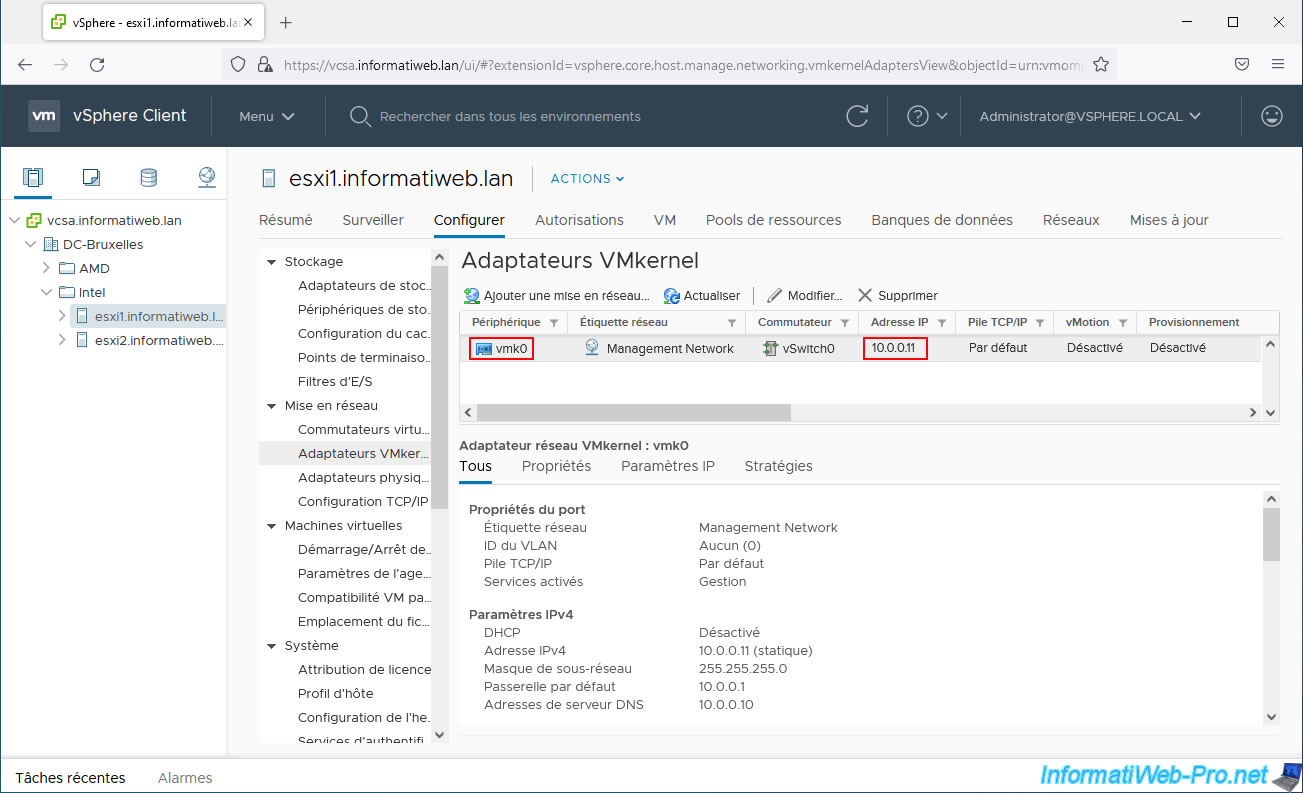
If you go to "Configure -> Networking -> Virtual switches", you will see that your VMware ESXi host has by default a standard virtual switch "vSwitch0" with:
- a "Management Network" port group which notably contains a VMkernel port (VMkernel interface) "vmk0".
- a group of "VM Network" ports for network access to your virtual machines.
- at least one physical adapter (physical network card). By default, there is only one.
Important : a switch where you want to add a VMkernel port (VMkernel adapter) must always have at least one physical adapter.
Indeed, VMkernel adapters allow your hosts to communicate with each other via the physical network.
Additionally, you must create a new port group to add a VMkernel port (VMkernel adapter) to a virtual switch.
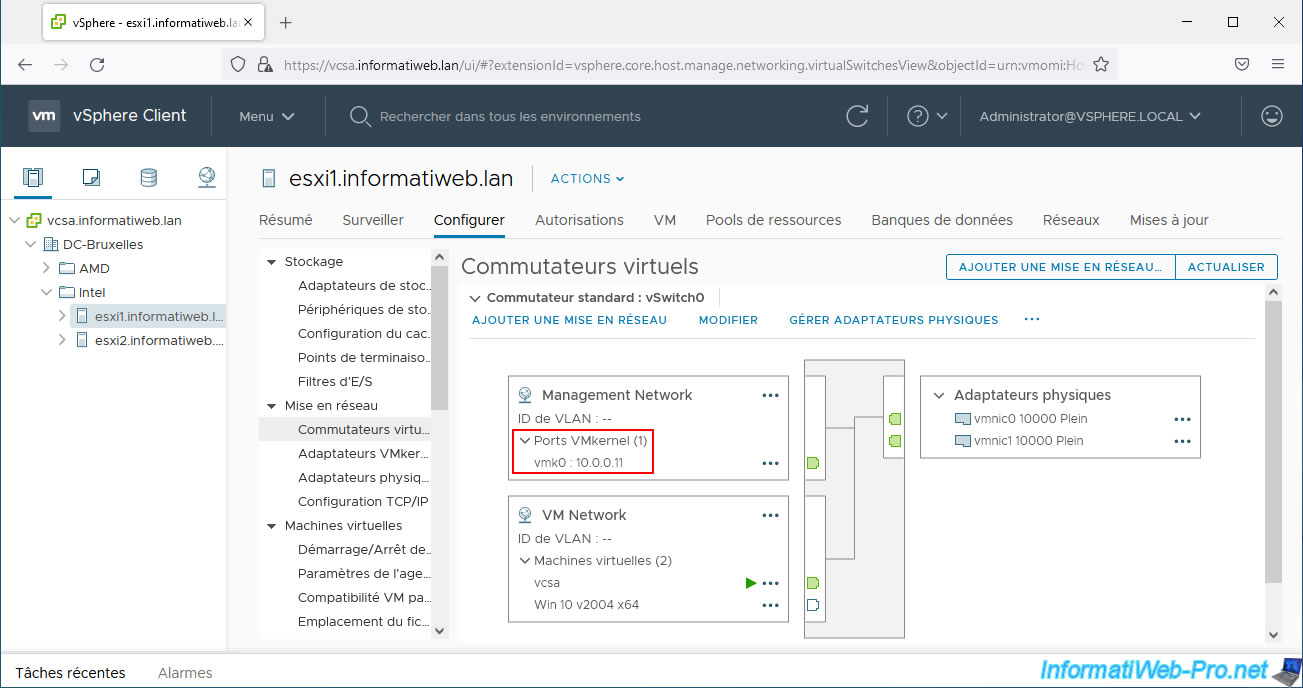
2. Add a VMkernel adapter (VMkernel port)
To add a VMkernel adapter (VMkernel port) from the VMware vSphere Client, simply go to "Configure -> Networking -> Virtual switches" and click on "Add Networking".
Note: on VMware vCenter Server (VCSA), you can create a VMkernel adapter and all the network components required for it in a single wizard.
Unlike the web client of your VMware ESXi host where you must create the different components separately.
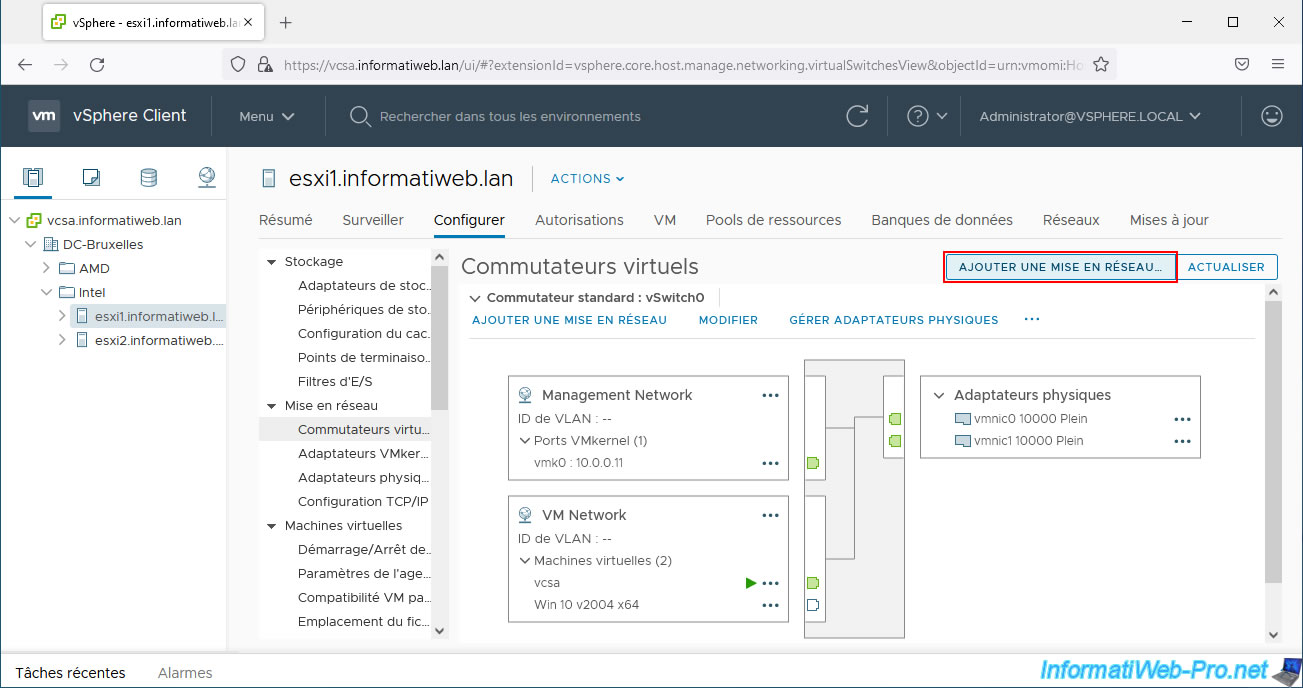
In the "[VMware ESXi host name] - Add Networking" wizard that appears, select "VMkernel Network Adapter".
As the wizard tells you, creating a VMkernel network adapter allows you to manage traffic for ESXi services: migration of VMs via vSphere vMotion, host management, ...
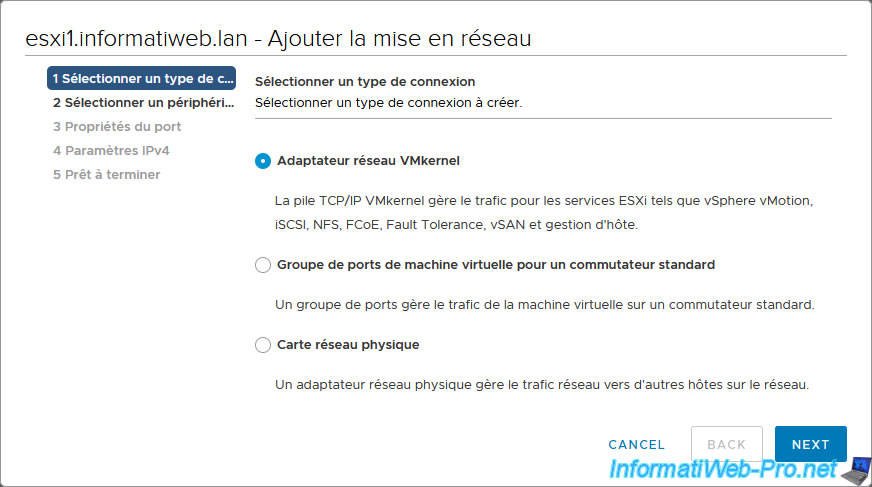
Following VMware best practices, it is recommended to separate network traffic from different ESXi services by creating a new virtual switch for each VMkernel adapter.
To do this, select "New standard switch".
By default, the MTU is 1500 bytes. Which defines the maximum amount of data that can be sent in a single network packet.
To use Jumbo frames, you will need to specify a value greater than 1500.
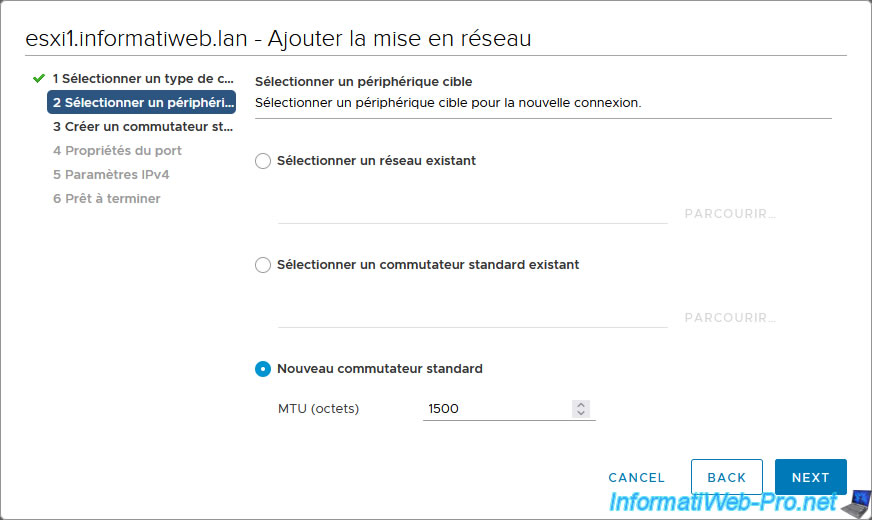
As explained previously, when you want to create a VMkernel adapter on a virtual switch, it is necessary that it has at least one physical adapter.
Otherwise, your VMware ESXi hosts would not be able to communicate with each other via your physical network.
To add a physical adapter to your new standard switch, click the "+" icon.

Select the desired physical adapter and click OK.
Note: to learn more about the information displayed here, refer to our tutorial: VMware vSphere 6.7 - Create a new virtual network.

In our case, we added 2 physical adapters for fault tolerance reasons.
But, it will also work with a single physical adapter.

In the "Port properties" step, you can configure:
- Network label: the name of the port group that will be created on your new virtual standard switch (vSS) and into which your new VMkernel adapter will be added.
- VLAN ID: VLAN ID to use on the port group that will be created. Default: "0" to not use VLAN.
However, if you do not have the ability to create different virtual switches to separate traffic from your different VMkernel adapters, VMware recommends that you create multiple port groups with different VLAN IDs on your virtual switch and create an adapter VMkernel per port group.
This will allow you to better isolate the network traffic of your different VMkernel adapters. - IP settings: allows you to choose whether you want to use only IPv4, only IPv6 or both (IPv4 and IPv6).
In our case we will only use IPv4. - MTU: Allows you to set a different MTU on the VMkernel adapter if desired.
By default, the wizard will use the same MTU as your standard virtual switch. - TCP/IP stack: since vSphere 6.0, it is possible to use different TCP/IP stacks. This makes it possible to use different gateways and better separate the network traffic of the different ESXi services.
Generally, you will use the "Default" TCP/IP stack, but you also have the option of using the following TCP/IP stacks:- Provisioning: for migrating snapshots and cold virtual machines.
- vMotion: for live migration of virtual machines.
- Enabled services: allows you to choose which services can be used via this VMkernel adapter.
Preferably, enable only one service per VMkernel adapter for performance and security reasons.
We recommend that you separate the network traffic of the "management" service from other services to prevent your VMware ESXi hosts from becoming unavailable and to prevent them from randomly disconnecting from your VMware vCenter Server (VCSA).- vMotion: migration of virtual machines via vSphere vMotion.
- Provisioning: migration of snapshots and cold virtual machines.
- Fault Tolerance logging: data transferred from the primary VM to the secondary VM when you implement vSphere Fault Tolerance (FT).
- Management: host management traffic. Access via SSH or through the VMware ESXI host web interface, as well as traffic between the VMware ESXi host and the VMware vCenter Server (VCSA) to which it is linked.
- vSphere Replication: network traffic related to replication data transferred from the source site to the destination site when you implement vSphere Replication.
- vSphere Replication NFC: Inbound traffic received from the source site when vSphere Replication is implemented.
- vSAN: network traffic related to the creation of a vSAN cluster.
Source : VMkernel Networking Layer.

For this tutorial, we chose to use the vMotion service.
So, we select the "vMotion" TCP/IP stack to separate vMotion traffic from the rest of the network traffic on our VMware ESXi host.
Note that when you select the "vMotion" TCP/IP stack, all boxes in the "Enabled services" section are automatically grayed out and the "vMotion" box is automatically checked.

For IPv4 settings, select "Use static IPv4 settings" to be able to manually set a static IP address for this VMkernel adapter.
- IPv4 address: static IPv4 address that your VMkernel adapter should use.
- Subnet mask: Subnet mask to use.
In our case, we use the subnet mask "255.255.255.0". Which means that the networks "10.0.0.x" (for the management network) and "10.10.0.x" (for the vMotion network) are different networks in our case. - Default gateway: if you have a gateway (router) on the physical network affected by your virtual switch, you can indicate it here.
In our case, there is none.

A summary of the configured network configuration appears.
Click Finish.

Your new virtual switch appears with:
- your new port group: vMotion Network.
- your new VMkernel adapter "vmk1" with IP address "10.10.0.11" in our case.
- its physical adapter(s) so that the host can communicate over the physical network.

Share this tutorial
To see also
-

VMware 6/15/2022
VMware ESXi 7.0 / 6.7 - Enable SSH protocol
-

VMware 8/23/2024
VMware vSphere 6.7 - Enable Jumbo frame support
-

VMware 9/24/2025
VMware vSphere 6.7 - Migrate VMs via vMotion (vSS / L2 network)
-

VMware 6/28/2024
VMware vSphere 6.7 - Tasks and events


You must be logged in to post a comment